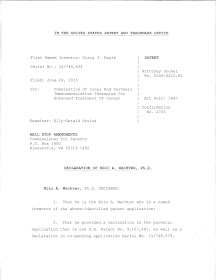PART A
I previously wrote about the concepts of additivity and synergy when adding two agents together (a "combination") or three or more together (a "cocktail"). See
The bar (June 24, 2016) and
Additive: 1 + 1 < 2. Synergistic: 1 + 1 > 2 (best case, >> 2) (June 25, 2016) on
the blog's Current News page.
Additive in the context of immuno-oncology combinations and cocktails represents one plus one is less than or equal to two (or, in the case of three agents, one plus one plus one is less than or equal to three). Efficacy (e.g., response rate, and perhaps other survival and survival surrogate endpoints) of the combination is better than the individual efficacies of the pair's components. That is, the sum of the parts is greater than the whole.
A synergistic combination, however, should generate efficacy greater than the sum of the individual efficacies, and, in a best case, much greater than the sum, That is, the whole is greater than the sum of the parts
- 1 + 1 > 2, and in the best case 1 + 1 >> 2
I updated MD Anderson's Dr. Merrick Ross, MD's slide no. 160 of ASCO 2016 Melanoma Symposium's
"The Role of Immunotherapy in the Medical Management of Melanoma: An Overview for the Oncologist" for preliminary combination data of oncolytic virus CVA 21 (Coxsackievirus A21) and ipilimumab/Yervoy in Stage III and IV melanoma patients. The upshot for this latest addition, which Dr. Ross probably didn't include because the data is partial (some of the patients treated, but not all) and preliminary, is that CVA 21 and ipilimumab are synergistic, as are oncolytic virus T-Vec and ipi; however, T-Vec and pembro are potentially additive but not synergistic.
 |
| Click to enlarge |
PART B
As I noted under
Is Pfizer paying more [IP] attention to Provectus? (September 2, 2016) on the blog's Current News page, Provectus recently advanced daughter combination therapy patent application '318 (co-assigned with Pfizer) after an initial non-final rejection decision by the U.S. Patent and Trademark Office. Provectus' CTO Dr. Eric Wachter, PhD had a document, as part of this advancement, filed on August 31st. See the several pages below, with my orange emphasis.
 |
| Click to enlarge |
 |
| Click to enlarge |
 |
| Click to enlarge |
 |
| Click to enlarge |
 |
| Click to enlarge |
 |
| Click to enlarge |
 |
| Click to enlarge |
PART C
H/t InvestorVillage poster STARLIGHT66 for a Barron's August 31st article entitled
"Merck: Lung Cancer Lead Depends On “How Smart It Plays Its Hand,”" notably the quote by Bernstein analyst Tim Anderson:
"One of the frequent criticisms with MRK’s I/O program has been that, relative to competitors like BMY/AZN and Roche, its “combination” strategy is less clear, with many believing MRK could be left in the cold over the long run because of this. This is too simplistic of a view, in our opinion.
MRK has already placed its bets on “chemo combo” through the earlier initiation of trials like Keynote-189 and Keynote-407. In the area of CTLA4 combinations, we believe the chances are high that MRK will soon initiate a phase 3 development program (exact scope unclear) if only to hedge its bets in the event that trials like Checkmate-227 and MYSTIC/NEPTUNE are positive.
While the onus is on BMY and AZN to fully validate CTLA4 combinations, all MRK has to do is imitate given its sudden lead in the monotherapy 1L lung cancer market that came about through the very different fates of Keynote-024 and Checkmate-026.
In other potential combination areas with anti-PDx therapies and “3rd generation” agents (e.g. OX40, GITR, IDO, and more) the playing field is more level across the different drug companies. Like its competitors, MRK already has various assets in development – either owned in entirety or accessed through partnership. Progress with almost all of these later generation drugs, across all companies, has seemed to be on the slower side; activity in a single-agent setting, for example, has often seemed underwhelming, in contrast to the single agent activity seen with the anti-PDx’s and anti-CTLa4′s.
Lastly, even if “combination therapy” comes to fruition and the data is compelling (whatever the regimen), there will likely be the attendant trade-offs of incremental toxicity and higher cost. Therefore, it seems likely that some segment of the 1L lung cancer market will continue to exist for anti-PDx monotherapy, where MRK has a first-mover advantage.
On balance, we continue to think investors under-appreciate the potential durability (and value) of MRK’s coming lead in 1L lung cancer. Part of this depends on how smart MRK plays its hand from here."
I think it's pretty clear Eric is signalling or outright saying the combination of Provectus' intralesional agent PV-10 (Rose Bengal) and Merck & Co.'s anti-PD-1 drug pembrolizumab for patients with advanced melanoma is synergistic. Is he foretelling the results are stellar? Could efficacy exceed, at a minimum, the response rate of Bristol-Myers' combination of anti-CTLA-4 drug ipilimumab and anti-PD-1 drug nivolumab?
The Barron's article suggests Merck is searching for the ideal front-end (perfect primer) to marry to/combine with pembrolizumab. How will the Big Pharma "play its hand?"








No comments:
Post a Comment